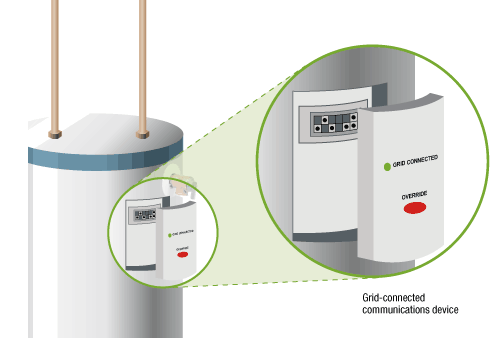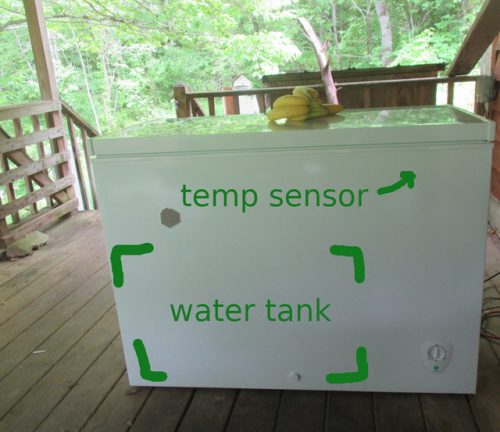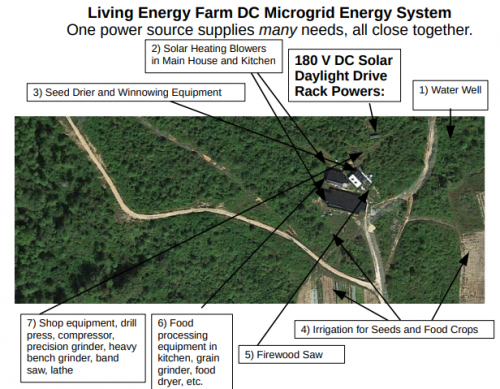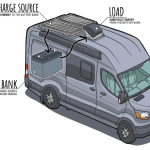Joey Hess has designed, built and tested an off-grid, solar powered fridge, with no battery bank. Using an inexpensive chest freezer with a few modifications, the fridge retains cold overnight and through rainy periods. The set-up consists of a standard chest freezer, an added thermal mass, an inverter, and computer control. He writes: [Read more…]
Off-Grid, Solar-Powered, Zero-Battery Refrigerator
“Daylight Drive” DC Solar Power at the Living Energy Farm
Reader Goran Christiansson sends us a link to Living Energy Farm, a research and community project in Virginia, USA. Most notable is their use of “Daylight Drive” DC solar power without batteries for workshop tools — reminiscent of the ideas outlined in How to run the economy on the weather. Also of note is their choice for less efficient but more durable Nickel Iron batteries for lighting. [Read more…]
Battery Killers: Grid-Interactive Water Heaters
 Grid-interactive water heaters (GIWHs) add bidirectional control to electric resistance water heaters, allowing a utility or third-party aggregator to rapidly toggle them off and on. This functionality turns a fleet of water heaters into a flexible energy-storage medium, capable of increasing and decreasing the load on the grid on a second-by-second basis.
Grid-interactive water heaters (GIWHs) add bidirectional control to electric resistance water heaters, allowing a utility or third-party aggregator to rapidly toggle them off and on. This functionality turns a fleet of water heaters into a flexible energy-storage medium, capable of increasing and decreasing the load on the grid on a second-by-second basis.
GIWHs are currently the least expensive form of energy storage available. Utilities can use fleets of grid-enabled water heaters for load shifting, demand response, arbitrage, ancillary services, or to respond to unexpected grid-stabilization events. Traditional dissemination of new water heater technology has been a painstakingly slow process, but water heater rental programs may greatly accelerate this process.
Read more: Battery Killers: How Water Heaters Have Evolved into Grid-Scale Energy-Storage Devices, David Podorson.
Related: How sustainable is stored sunlight?
The Energetic Implications of Energy Storage
“When renewable energy sources such as solar and wind farms generate more electricity than consumers need, storing the excess doesn’t always make sense. Large, grid-scale batteries capable of storing the extra electricity are resource-intensive and costly to manufacture and maintain — sometimes more so than the energy they’re used to store.”
The energetic implications of curtailing versus storing solar- and wind-generated electricity, Charles J. Barnhart et al, Energy & Environmental Science, Issue 10, 2013. Open access. Via Eurekalert and Yale Environment 360.
Finally: A Life Cycle Analysis of Electric Cars
“We develop and provide a transparent life cycle inventory of conventional and electric vehicles and apply our inventory to assess conventional and EVs over a range of impact categories. For all scenarios analyzed, the use phase is responsible for the majority of the global warming potential (GWP) impact, either directly through fuel combustion or indirectly during electricity production.”
Total emissions
“When powered by average European electricity, EVs are found to reduce GWP by 20% to 24% compared to gasoline ICEVs and by 10% to 14% relative to diesel internal combustion engine vehicles (ICEVs) under the base case assumption of a 150,000 km vehicle lifetime. When powered by electricity from natural gas, we estimate EVs offer a reduction in GHG emissions of 12% compared to gasoline ICEVs, and break even with diesel ICEVs. EVs powered by coal electricity are expected to cause an increase in GWP of 17% to 27% compared with diesel and gasoline ICEVs. Wind power electricity would allow electric transportation with life cycle carbon footprints as low as 106 g CO2-eq/km.”
Vehicle production: Manufacturing one electric car takes as much energy as manufacturing two conventional automobiles
“In contrast with ICEVs, almost half of an EV’s life cycle GWP is associated with its production. We estimate the GWP from EV production to be 87 to 95 grams carbon dioxide equivalent per kilometer (g CO2-eq/km), which is roughly twice the 43 g CO2-eq/km associated with ICEV production. Battery production contributes 35% to 41% of the EV production phase GWP, whereas the electric engine contributes 7% to 8%. Other powertrain components, notably inverters and the passive battery cooling system with their high aluminum content, contribute 16% to 18% of the embodied GWP of EVs.”
“Comparative Environmental Life Cycle Assessment of Conventional and Electric Vehicles“, Troy R. Hawkins, Bhawna Singh, Guillaume Majeau-Bettez, Anders Hammer Strømman, in “Journal of Industrial Ecology”, October 2012. Via the BBC and Treehugger. Picture: Trexa. Previously: The status quo of electric cars: better batteries, same range.
A Nation-Sized Battery
“Putting the pieces together, our national battery occupies a volume of 4.4 billion cubic meters, equivalent to a cube 1.6 km (one mile) on a side. The size in itself is not a problem: we’d naturally break up the battery and distribute it around the country. This battery would demand 5 trillion kg (5 billion tons) of lead. A USGS report from 2011 reports 80 million tons (Mt) of lead in known reserves worldwide, with 7 Mt in the U.S. A note in the report indicates that the recent demonstration of lead associated with zinc, silver, and copper deposits places the estimated (undiscovered) lead resources of the world at 1.5 billion tons. That’s still not enough to build the battery for the U.S. alone. But even then, we aren’t done: batteries are good for only so many cycles (roughly 1000, depending on depth of discharge), so the national battery would require a rotating service schedule to recycle each part once every 5 years or so. This servicing would be a massive, expensive, and never-ending undertaking.” Read more: A Nation-Size Battery.







